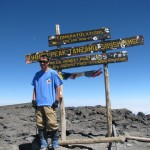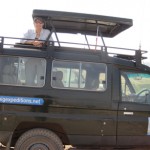From Alaska to the top of Africa
November 30, 2010
907-474-7468
November 30, 2010

An Alaska teacher and an eighth grade student are now seeing the world differently after a visit to the other side of the planet.
Jenny Heckathorn, a biology teacher from Valdez, and Spencer Adams, a 14-year-old from Palmer, climbed Africa's highest peak this fall. The trip was part of the Global Learning and Observations to Benefit the Environment Seasons and Biomes program and GLOBE Africa.
The GLOBE program also enabled them to explore Tanzania's Olduvai Gorge and Serengeti National Park. "What impressed me most were the similarities between African animals and North American animals," Heckathorn said via phone from her Valdez classroom. "The herd of zebras smelled and acted just like horses; the spotted jackal up close could have been a coyote; reedbucks look just like whitetail deer from a distance; (Ngorongoro) crater looked just like Yellowstone Park, but there were wildebeests instead of vast herds of bison . . . I just kept thinking, 'Wow, that reminds me of back home.'"

Heckathorn also teaches physical education. To get in shape for a trek up Tanzania's snowless Mount Kilimanjaro, which at 19,331 feet is just 1,000 feet shy of Denali's summit, she made many treks up Town Mountain behind Valdez.
Heckathorn also embarked on a cross-country hike to Shoup Glacier from Valdez, to then kayak back to town. She and the other Alaskans taking part in the GLOBE trip up Kilimanjaro did well on the mountain, said Kenji Yoshikawa, a scientist at the University of Alaska Fairbanks.
Yoshikawa found permafrost near the summit of Kilimanjaro last year and returned this year. Robbie Everett, Adams' teacher, and Everett's son Parker were the other Alaskans on the trip. Adams celebrated his 14th birthday during the nine-day trek from the rainforest at Kilimanjaro's base to the stranded glaciers at its summit. "We tried playing Frisbee at 17,000 feet and we got really tired really fast," said Adams, an Inupiaq Eskimo who may have become the first Alaska Native to summit Kilimanjaro.
Adams prepared for the trek by running hills with his cross-country team at his school in Palmer. Since he had lived most of his life in Kotzebue, a few feet above sea level, he wondered how he would perform on the mountain. "I never really felt like my muscles were really tired, but the thin air made me tired," he said. "It was really beautiful. When you looked behind you could see all the places we'd stopped and camped out."
Adams said he learned a lot on the trip to Tanzania, and he hopes to return there someday. "I learned that climate change could affect anything: plants, animals, and water," he said. "I want to keep track of those glaciers receding on Kilimanjaro and different things in Alaska, like the permafrost in Kotzebue, see how it's (thawing) and how Alaska is changing over the years. And I want to go back (to Africa) in a few years and see what it's like."
The people of Tanzania impressed Adams with their friendliness and work ethic. "Porters carried chairs and tents up (the mountain) for us," he said. "It was pretty amazing . . . We saw African people on the side of the road with big things of wood on their heads - people there just work really hard."
Heckathorn agreed with Adams' assessment of the difference between there and here. "I would love to go back in about five years with my own son, who will be 15 then," she said. "I'd like him to see what life is like in other parts of the world. The living conditions we take for granted here: our homes, vehicles, our water supply, food options, quality of the roads, everything. It's just a night and day difference."
Heckathorn returned to Valdez with plenty to share with her students. "I came back with the best memories, experiences, stories, pictures and motivation to bring students to that part of the world," she said.
This column is provided as a public service by the Geophysical Institute,
University of Alaska Fairbanks, in cooperation with the UAF research
community. Ned Rozell is a science writer at the institute.


